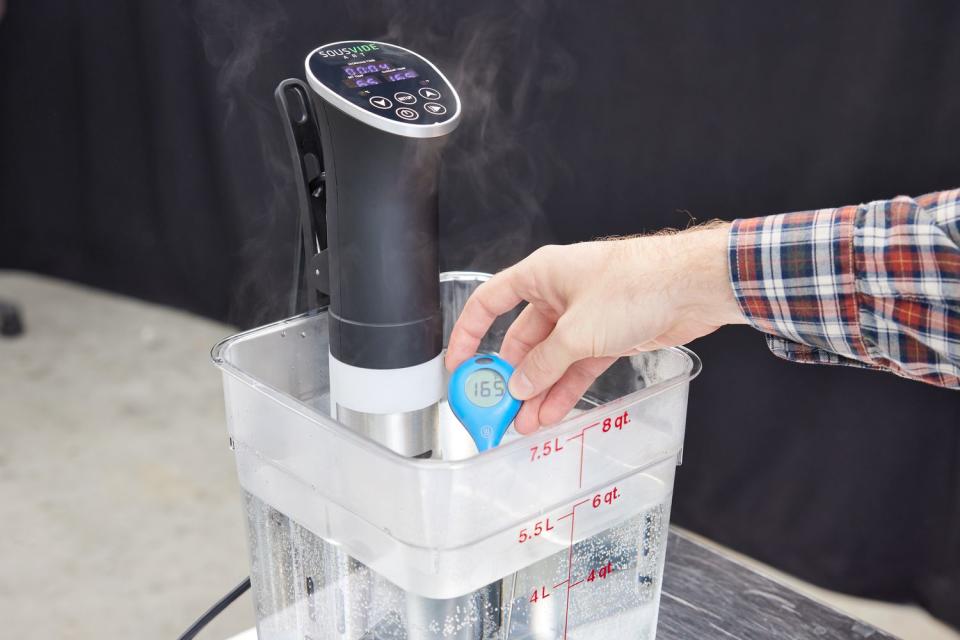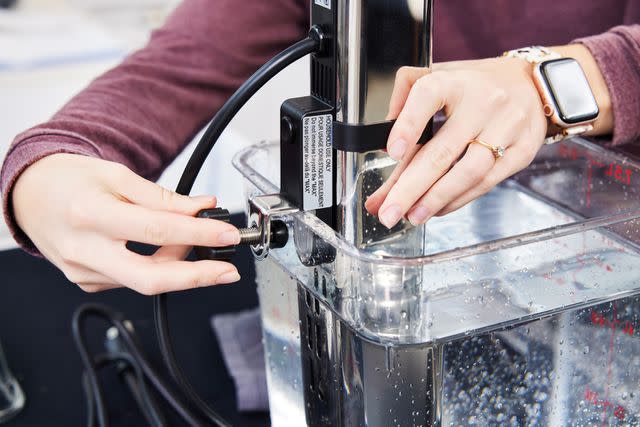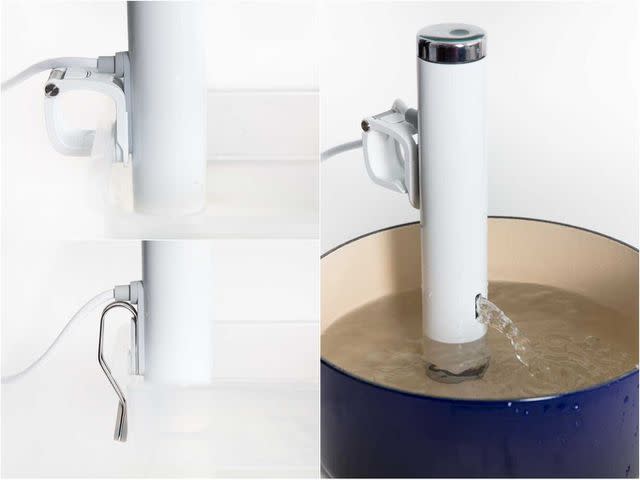The Best Sous Vide Containers (Some, You Might Already Have)
Dotdash Meredith and Yahoo Inc. may earn commission or revenue on some items through the links below.
The best container for cooking with sous vide is durable, heat-proof, and tall enough to accommodate your immersion circulator.

Serious Eats / Russell Kilgore
If you’re considering taking the leap into sous vide cooking, you’re going to need more than just a great immersion circulator. Because the sous vide method relies on a water bath kept at a precise, consistent temperature, you’ll want a container that’s heat-proof, durable, non-reactive, and—here’s where most home cooks go wrong—tall enough to accommodate your immersion circulator.
The water capacity varies slightly across brands, but for the most part, you’ll need a minimum water depth of 2.5 inches (that’s just to accommodate the immersion circulator; you’ll want higher water levels to completely submerge the food you’re cooking). One of our favorite immersion circulators, the Anova Precision Cooker, maxes out at five gallons of water, although that’s an excessive amount for home cooks—not to mention would require an unnecessarily long heat-up time.
The good news: although immersion circulators are pricey, most containers for sous vide are refreshingly affordable and accessible (and you may already have some). And you don’t even need a lid for your sous vide container. If you’re planning on cooking for a long time, you may be worried about water evaporation. To mitigate this, in lieu of a lid you can cover the surface of the container with ping pong or sous vide balls (steam will condense on the balls and drip back down into the water bath). Sous vide-specific balls are smaller and generally come with a handy storage pouch.
Cambro Containers
Cambro Containers

Cambro 8-Quart Storage Container

Most of us at Serious Eats are big fans of Cambro containers—and not just for sous vide cooking. These durable, lightweight, inexpensive, thick-walled plastic food storage containers are prized among professional cooks, thanks to the volume gradations and an impressive number of sizes. A note here: Cambro also makes containers from polypropylene, which are cheaper and thinner, but not able to withstand higher temperatures. A polycarbonate container is the one you want for this purpose.
Although small-medium size (4.75 quarts) Cambros are technically big enough for most home cooks’ needs, a 6- or 8-quart is only slightly more expensive and has the benefit of taller walls. Those taller walls are crucial if your sous vide machine doesn’t have an adjustable clip or attachment mechanism, like this one from Instant.
You don’t need to cover your container with a lid when cooking sous vide. But if you plan on using your Cambro for food storage, you may want one. Not all retailers sell Cambro containers with their lids, so if that matters to you, double-check your online cart before purchasing. Price varies slightly with or without lids, and across retailers.

Serious Eats / Russell Kilgore
Stock Pots
Cook N Home 12-Quart Stainless Steel Stockpot with Lid

Tramontina 16-Quart Gourmet Stainless Steel Covered Stock Pot

A large stock pot will work with your immersion circulator, with a caveat: taller pots fare better with most models, which need to stand upright to work correctly. A pot or container with short sides may cause the immersion circulator to rest against the edge at a tilt, which can negatively impact temperature regulation.
The most common size of stock pot for home cooks is 12 quarts, which works just fine for sous vide cooking. Bear in mind that the larger your container (and the more water it contains), the longer it will take to initially heat the water to your desired temperature.
We recommend stainless-steel stock pots over aluminum, for steel’s non-reactivity—it will serve you well as a more traditional cooking vessel, too. The versatility of a stock pot (and our next pick, a Dutch oven) is what makes it so convenient for most cooks: you likely already have one, and thus won’t need to make room for yet another piece of cooking equipment.
Dutch Ovens
Le Creuset Enameled Cast Iron Signature Round Dutch Oven, 5.5 qt

Staub Cast Iron 5.5-Quart Round Cocotte

You can use an enameled cast iron Dutch oven for sous vide cooking, too. The most common size is 5.5 quarts, which is sufficient for most home cooking projects. Bare cast iron Dutch ovens aren’t as common, but they’re not a great choice for sous vide cooking: it’s the enamel coating that protects the cast iron from water exposure and rust. Our favorite Dutch ovens come from Le Creuset and Staub.
Most Dutch ovens are shorter-walled than stock pots. If your immersion circulator’s side clip can be adjusted to accommodate those comparatively lower sides without tilting, you’re ready to rock. Some circulators—like our top pick from Joule—have magnetic bottoms that allow them to stand upright in any magnetic container, although we still recommend clipping to the side for extra insurance during longer cooking tasks.
A potential downside of using a Dutch oven: they’re heavy, and may be harder to lift for some cooks.

Serious Eats / Vicky Wasik
Specialty Sous Vide Containers
EVERIE Sous Vide Container with Universal Silicone Lid and Sous Vide Rack

If coordinated cooking equipment weighs more heavily in your decision-making, you’ll probably like specialty sous vide containers. These unique containers are often thoughtfully designed to eliminate little annoyances that come with sous vide cooking.
For example, this model from EVERIE has a rack to keep bags upright during cooking (we typically recommend binder clips for this task) and a lid to reduce evaporation during long cook times. However, this container's big, at 12 quarts. And if you're short on storage space, you might not be into such a large unitasker.
FAQs
What’s the best container for sous vide?
Annoying, but there’s no hard-and-fast answer for this. You can use a variety of different containers for cooking with an immersion circulator, all to the same effect. Durable, heat-proof plastic containers are inexpensive and lightweight. Metal stock pots are versatile and almost always large enough to accommodate whatever you’re cooking. Enameled cast iron Dutch ovens are versatile too and have excellent heat retention. Specialty containers, often made by immersion circulator brands, have lots of bells and whistles, which could come in handy if you rely on this method of cooking regularly. If you plan on cooking on the stovetop while using your immersion circulator, you will benefit from having a dedicated sous vide container. But if you plan on using the appliance sporadically, your trusty stock pot or Dutch oven will do the trick.
What’s the best sous vide container with a lid?
Although you don’t need a lid to cook with sous vide, they’re handy for longer cooking sessions because they maintain the water level. This container, from EVERIE, has a lid. For a container without a lid, you can use ping pong or sous vide balls to maintain the water level.
Can I sous vide in a plastic container?
You can use some plastic containers for sous vide. Do NOT use basic food storage containers for sous vide, even if they are very large. The plastic will warp or melt at higher temperatures. The keyword is “polycarbonate,” which signifies a durable, heat-resistant plastic that will last for years.
Can you use any container for sous vide?
Although you don’t need to buy a sous-vide-specific container, you can’t just grab any vessel in your kitchen. A sous vide container should be at least four quarts in volume, have tall enough sides to accommodate the immersion circulator, and—of course—be able to withstand sustained, high temperatures. Just as important are the tools you use with your container: you’ll need a plastic bag with a strong seal (Ziplock-style freezer bags are fine), a binder clip to attach it to the side, and a trivet or pot holder to act as a barrier between your counter and the vessel. We also recommend ping-pong or sous vide balls to help maintain water levels.
Read More:We Tested 18 Sous Vide Machines (Immersion Circulators)—Here Are Our Favorites

